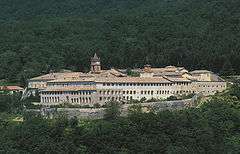Trisulti Charterhouse
Coordinates: 41°46′46″N 13°23′51″E / 41.779393°N 13.397482°E


Trisulti Charterhouse (Italian: Certosa di Trisulti) is a former Carthusian monastery or charterhouse, now owned by the Cistercians, in Collepardo, province of Frosinone, central Italy. It is located on the slopes of Monte Rotonaria, a peak of the Monti Ernici, at 825 meters above the sea level. It was consecrated in 1211, becoming a national monument in 1873.
History
A first Benedictine abbey was founded in the site in 996 by Saint Dominic Abbot: some remains can be seen today not far from the current building. The latter was erected starting from 1204, on a more accessible location, by order of Pope Innocent III, who assigned it to the Carthusians. The abbey church, dedicated to Saint Bartholomew, was consecrated in 1211.
The name Trisulti could derive from Latin tres saltibus, meaning "at the three jumps": this was the name of a castle of the baronial Colonna family which commanded the three passes ("jumps") leading to Abruzzo, Rome and Ciociaria.
The complex was enlarged and modified several times in the following centuries. The current appearance dates from an essentially Baroque restoration.
In 1947 the monastery was taken over by the Cistercian Congregation of Casamari Abbey and continues as a Cistercian monastery.
Description
The abbey is surrounded by a massive line of walls. The entrance has a bust of Saint Bartholomew by Jacopo Lo Duca, a pupil of Michelangelo Buonarroti; this leads to a central square where there is a Romanesque-Gothic guesthouse, commonly known as the "Palace of Innocent III" (including a portico, a terrace and a library of 36,000 volumes), and the church of St. Bartholomew.
The latter, originally a Gothic-style building, has been largely rebuilt as a Baroque one. The façade, dating from 1798, was designed by Paolo Posi. The interior, like other Carthusian churches, is divided by an iconostasis into two sections. There are two wooden choirs: dating from 1564 and 1688, they were both created by Carthusian masters. Paintings include works by Filippo Balbi and, in the vault, the Glory of Paradise by Giuseppe Caci (1683). The latter also executed the altarpiece of Madonna Enthroned with Child and Saints Bartholomew and Bruno.
The complex also includes an 18th-century pharmacy, on two levels; it is decorated by trompe-l'oeil frescoes and contemporary furniture. The garden facing the pharmacy was once a botanic garden.